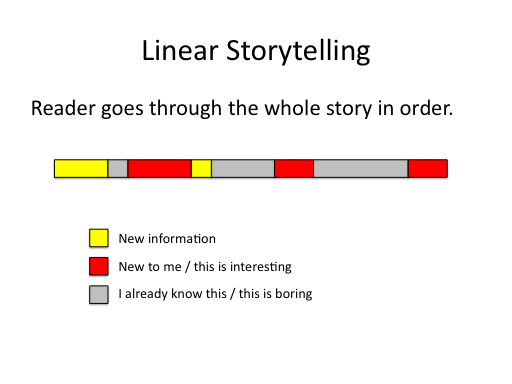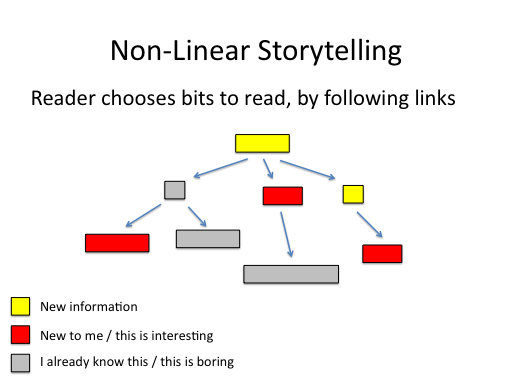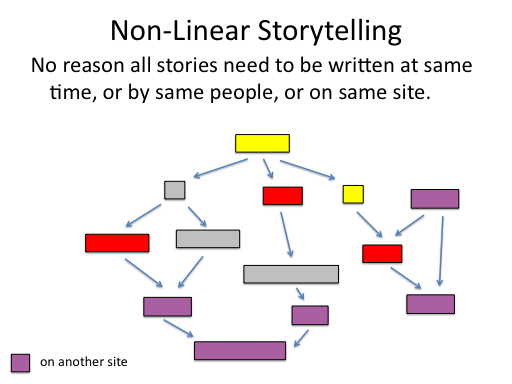Writing style needs to change to take advantage of the hyperlink. That’s the message I want to inject into the discussion about whether deep, long-form writing can survive online — especially long-form journalism. Many people assert that articles need to be shorter online than they are in print, and Nic Carr even famously argues that the internet is making us stupid by destroying our attention span.
But I don’t think the web is shallow at all. I think it’s the deepest medium ever invented, with incredible potential for telling complex, irreducible stories — or at least it can be, if you don’t treat it like print.
Here’s how a long story works in print:

The yellow bits are the unique information that can only be found on that page. The other bits of writing are there to provide the context needed to make sense of the whole , or to get the reader up to speed if they don’t know the backstory. In print, this is absolutely necessary, because a print story is a self-contained object. There is no where else the reader can go to look up an unfamiliar term, to check out a sub-plot, or to investigate the history. That is why we have context paragraphs. That is why we have little definitions of terms that might be unfamiliar to some, and explanations of who a source is and why we should believe them.
Online is different. We can move the context, verification, and background out of the main story, paring the piece down to a thing of streamlined beauty — but all the depth is still there, via links, for anyone who wants it.

When I try to understand how the internet changes communication, one of the points I keep coming back to is the personal nature of online media: it’s now possible to present a different experience to every single reader (user? viewer?) Choosing whether or not to follow a link is a simple way for a reader to tailor the presentation to what they already know, and to indulge their own curiosity. And links let you skip the boring bits.
We’re used thinking of “an article” as a self-contained unit of story. It’s not. The component parts of a story might even be written at different times, published on different sites, or created by different authors.

And now our diagram looks like the web actually looks, lots of pages from different people about different aspects of a very complex world. That is the medium we write in, not some simulation of a stack of paper, no matter what your word processor shows you. Of course, the web also allows fully interactive stories, but it’s often forgotten that hypertext itself is an interactive medium — or it can be, when we put the right links in the right places. People have been experimenting with non-linear stories for decades, but given that a generation or two has now grown up with hypertext, it’s probably time to let our storytelling style grow up too.
Online, short doesn’t necessarily mean shallow. We’re just measuring “depth” wrong when we only look at a single article. That’s not how people actually consume the web, and we shouldn’t force them to.
I completely agree. I actually found this to be one of the biggest mental blocks to effective blogging – for a long time I was wedded to the idea that each post has to tell the whole (in my case usually scientific) story: which makes for long, complex posts. Yet in fact you can tell a long complex story in the form of a series of posts each of which expresses one idea. Once you get used to simply presenting one idea per post, it becomes easier to present complex ideas; I think it actually makes it harder to fool yourself (and others) with well-written, but logically flawed, arguments. Poor arguments are often of the form:
interesting stuff -> distracting filler -> interesting conclusion that doesn’t in fact follow
If you commit to just posting about the interesting stuff, and never writing filler, it becomes a lot harder to do that.
This is *exactly* what I’ve been saying for the past year or so – so, so great to see others thinking the same thing. If we want to treat the Web as a medium, we have to explore what forms best suit the medium, and that’s not just a case of distributing text, images and video/audio. It’s about using the Web as a Web. The possibilities around this are fascinating, and *need* to be explored.
Whoops, you got the wrong Carr: it’s Nic, not David.
You’re right, thanks, fixed.
Je ѕuis tout à ffait du même aviѕ que toi